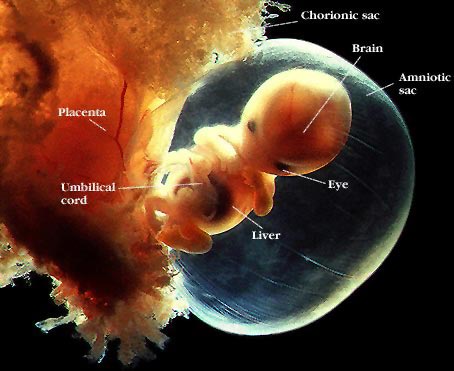Editors’ Note: This meditation first appeared on April 24, 2014, on the youth page of “De Wachter Sions,” a weekly publication of the “Gereformeerde Gemeenten in Nederland.” It was translated for the Reformed Pro-Lifer and is reprinted here with permission from the editor.
You have probably seen a picture of a pre-born child, similar to the one I have in front of me while writing. It’s a beautiful full-colour image of an embryo five weeks after fertilization, about ten millimeters long. That’s only a third of an inch!
The subscription reads, “The head will begin to straighten and separate more from the torso. Eyes, nose, and mouth are clearly distinguishable—the eyes are developing to the extent that the cornea is beginning to form. The ear canal and ears are further forming this week, as are the limbs, though legs and feet grow somewhat slower than the arms and hands.”
The photo below this text shows a frontal image of the tiny head—the start of a recognizable face, eyes, nostrils, and a small opened mouth with the upper lip slightly pulled up. And all of that is part of a head of less than half a centimeter!
Psalm 139
There’s one thing I don’t see in these pictures: a uncoordinated clump of cells. Yet, in Psalm 139 verse 16, the Dutch Statestranslation (Statenvertaling) refers to the clearly formed embryo as an “unformed clump”—”Uw ogen hebben mijn ongeformeerde klomp gezien.” How is this possible?
Was David wrong? Was he not inspired by the Holy Spirit in writing Psalm 139? Is is not true for him, “For the prophecy came not in old time by the will of man: but holy men of God spake as they were moved by the Holy Ghost” (2 Peter 1:21)?
Of course it is true that today’s advanced technology was not available at that time to capture images in the womb. Yet, the Bible cannot contradict reality—or can it? What we see in pictures like the one mentioned above by no means is an imperfect substance. Do the Bible and science contradict each other perhaps? You may not even dare to think or ask this but… is the Bible wrong in this case?
Translation
In situations like these, it is important to distinguish between the languages in which the Bible was written on the one hand, and the translation of that text on the other hand. God’s Word was inspired in the original language. Only of that version (Hebrew in the case of Psalm 139) we can say that it does not contain errors.
Then there’s the translation. The Dutch Statestranslation is generally known by friend and foe to be the most accurate Dutch version. It is nevertheless likely that small mistakes were made during the translation process. So let’s take a look at the translation of Psalm 139 verse 16, specifically the description of the young human embryo. Could this be a mistake?
As it turns out, the passage speaks of the very first beginning of a human being. The annotation to the Dutch Statestranslation explains that imperfect substance or unformed clump, in fact, refers to the very first period of our life, beginning at fertilization.
While contemplating this, I turn again to prenatal development pictures. What does an embryo look like one week after fertilization? When a sperm and an egg cell become one, cell division immediately takes place and it multiplies into all directions. To illustrate, there’s a picture of a small bunch of eight cells, then sixteen. In our beginning stages, during that first week after fertilization, we are an unformed clump of barely a milimeter.
The subscription of one image reads, “When the clump of cells reaches the uterus it consist of about 100 cells and is called a blastocyst.” There’s even a scientific term for this little clump! I cannot help but think that the Dutch translators were (no doubt unconsciously) far ahead of their time in calling a newly conceived human embryo “an unformed clump.”
The original
So what does the Hebrew text say? The inspired version of Psalm 139 verse 16 uses the word “substance,” the same word found in the King James Version. What is a substance? A dictionary defintion points us to “the foundation or core of a matter” or “the real physical matter of which a person or thing consists and which has a tangible, solid presence.” What a fitting word, especially considering what we know now!
When an egg cell and a sperm cell fuse, the new nucleus contains an entirely unique composition of DNA. The countless genetic characteristics of this new human being are stored there from his or her very beginning, and with every cell division the DNA is copied and passed on to the next cell. Physically speaking, this is the basis of an independent body and everything that functions within; in other words, a substance.
Add to this the imagery of verse 15—wrought or woven together—and you can’t help but be in awe at the knowledge and wisdom given to David by the Holy Sprit. The human body is like a piece of embroidery, made of many individual cells that together grow and form one final whole, and the blueprint can be found in each and every cell.
Have you ever thought about the process of growth? From the seemingly unformed clump or imperfect substance the cells multiply into all directions. Due to the continually copying example found in one’s DNA, the body internally “knows” exactly where the arms, legs, ears, nose, mouth, eyes, etc. have to be formed. Mindblowing!
When all goes well, the body is equipped in such a way that the heart can beat; that we develop eye sight, hearing, taste buds, and a sense of smell; and that our arteries, nervous system, gestational tract and many other systems begin to function. It is no wonder that David exclaims in verse 14, “I will praise thee; for I am fearfully and wonderfully made: marvellous are thy works; and that my soul knoweth right well!”
Of me
Did you notice that it says my substance? This implies that even this very beginning is of the person David, of me! “Thou hast covered me in my mother’s womb.” “I was made in secret, and curiously wrought in the lowest parts of the earth.” That is when David, by God’s providence, came into existence. That is true for all of us. And that is also when the soul enters the body. Do you now understand our opposition to birth control, one of the arguments being that a separate and unique human may be destroyed during the very first stages of his or her life?
Yet, the essence and significance of this Psalm can be found much higher than in the physical alone. God’s might and providence in forming each human being is incredibly great—no doubt about it. But the greatest wonder for David was that this high and holy God was merciful to him, a wicked sinner. David received faith to believe that he, from all eternity, was known by God and loved by Christ—and that everything in life, also concerning his body, was provided for by His faithful Father, already long before David was born.
Blessed David!

